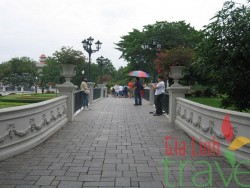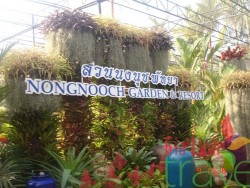Ayutthaya
Thailand Geography
Chiang Mai Nong Nooch Garden The Kingdom of Thailand, previously known as Siam, is situated in the heart of Southeast Asia with Bangkok as the capital city. It shares a border with Cambodia to the east, Laos to the northeast, Myanmar to the west, and Malaysia to the south. Thailand, with its shape resembling a head of an elephant, is around 198,114 square miles, or roughly the size of the state of Texas. Thailand, although rich in rubber and in mineral resources, was never colonized by Europeans and has existed as a unified monarchy since 1350. The capital, BANGKOK, an attractive blend of Western and Thai architecture, was established in 1782. Thailand covers a land area of 513,115 square kilometers, from North 5° 30¨ to 21° and from East 97° 30¨ to 105° 30¨, and extends about 2,500 kilometers from north to south and 1,250 kilometers from east to west, with a coastline of approximately 1,840 kilometers on the Gulf of Thailand and 865 kilometers along the Indian Ocean. Thailand is divided into four natural regions: the north, northeast, the central plain, and the south. The North is a mountainous region comprising natural forests, ridges and deep, narrow, alluvial valleys. A mountainous area where winter temperatures are cool enough to allow the cultivation of temperate fruits such as apples, strawberries and peaches, the North offers the tourist a pleasing alternative to the bright lights of Bangkok and the beaches of the south and the Gulf of Thailand. Chiang Mai is the major city of the North. Also called “Rose of the North”, Chiang Mai is the focal point of local farming communities with a thriving market. It is also a popular tourist destination with both Thai and overseas visitors who enjoy the city’s slow pace of life, its many ancient temples, and its various cottage industries which are generally concentrated in villages on the city outskirts. Umbrellas, silverware, nielloware, woodcarving and silk are just some of the best known Chiang Mai products. In the northern forests, visitors can see elephant training camps (these huge beasts are still used in the teak forests) as well as the colorful nomadic tribes that still roam this corner of Thailand. There are also opportunities for rafting and trekking. The north, for centuries an independent kingdom and center of culture and religion, is dotted with many ancient historical sites and monuments, among them the Sukhothai Historical Park, the Doi Suthep Shrine in Chiang Mai, and the Phra Buddha Chinarat image in Phitsanulok. Northerners celebrate such festivals as Songkran [the traditional Thai New Year] and Phao Thien Len Fai,to name but two. The north is also home to a patchwork of hill tribes-the Musers, Yao, Meo,E-kaw, and Karen-who each possess their own distinctive culture and way of life. The lowland northerners are note as a gentle and hospitable people. In addition the region abounds with many natural attractions such as mountain scenery, caves waterfalls, and lakes. Other attractions include bargain hunting for local and tribal handicrafts in the bazaars and markets, while in the major towns Western-style night entertainment is widely available. In the northern forests, visitors can see elephant training camps [these huge beasts are still used in the teak forests] as well as the colorful nomadic tribes that still roam this corner of Thailand. There are also opportunities for rafting and trekking. Central Thailand, the basin of the Chao Phraya River, is a lush, fertile valley. It is the richest and most extensive rice-producing area in the country and has often been called the “Rice Bowl of Asia”. This is the heart of Thailand, the region where the original Thais first settled, attracted here by the extra – ordinarily fertile and to be found on either side of the Chao Phraya River and its tributaries. Much of Thailand’s early history was focused on this “basin”, with successive capitals, Sukhothai, Ayutthaya, Thon Buri, and finally Bangkok, being located in the region. 3. The Northeast of Thailand The Northeast region, or the Korat Plateau, is an arid region characterized by a rolling surface and undulating hills. Harsh climatic conditions often result in this region being subjected to floods and droughts. Known also as “Isan” the Northeast is a huge region with over 20 million inhabitants, most of who are engaged in agriculture of some king. Because of its inaccessibility in the past, the Northeast was able to develop its own version of the Thai culture. This is characterized by exotic festivals, folk dances, spicy food, as well as local accents and dialects influenced by neighboring Laos and Cambodia. Isan people owe their roots to the Laotians, though evidence of Vietnamese and Khmer influences abound. Khmer temples dating back to the 12th century can still be found here. Recent excavations also suggest that the Northeast was home to a flourishing Bronze Age civilization, some 5,000 years ago. As a whole, the Northeast is a colorful and culturally rich part of the country. The Southern region is hilly to mountainous, with thick virgin forests and rich deposits of minerals and ores. This region is teh center for the production of rubber and the cultivation of other tropical crops. Apart from being geographically different from the rest of Thailand, with its thick jungles, dramatically shaped mountains and countless beautiful islands, the South has its own economic, ethnic and political features. The south, which is flanked on two sides by the Andaman Sea and the Gulf of Thailand, is lined with sandy beaches and palm-fringed islands lying just offshore. Some of the finest beaches in the country are to found in Phuket, Samui, and the islands in Phangnga Bay, while inland are mountain scenery, caves, waterfalls, and steamy tropic jungles. The region was once a part of the mighty Srivijaya Empire and many significant ruins dating from that period have been discovered, such as the Chedi Wat Maha That in Nakorn Si Thamarat, more than a thousand years old. The south is rich in culture and festivals such as Chak Phra and Tenth Month festivals. Unique to the region is the sport of bull fighting, while local products of interest include ornaments made from sea shells, pearl oysters and hand-woven cloth. The south’s wealth has been based for centuries on its rubber and tin industries. This is changing with the advent of tourism; it is now the fastest growing tourist region in Thailand. This is being spear headed by the island of Phuket, now an international tourist destination, with such places as Koh Samui, Krabi, Hatyai and Songkla playing supporting roles.


1. The North of Thailand
2. The Central Plain of Thailand
4. The South of Thailand
